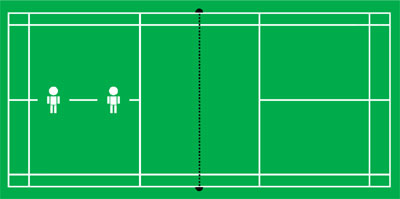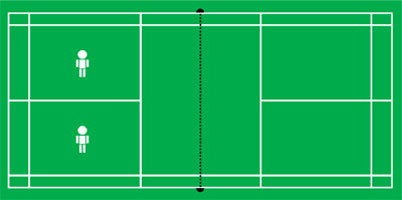How To Play Badminton
Unlike some sports, badminton is relatively inexpensive in equipment costs and fees. All you need to get started are a good pair of running shoes, a racket, some shuttlecocks, and a place to play. Badminton can be played either indoors or outdoors with the aid of a net.
To play badminton, you need to have a minimum of two players for a singles match and four players for a doubles match. Most professional matches play three games, with the first person/team reaching 21 by two or the first person/team reaching 30.
There is a 90 seconds rest period allowed between matches. A professional match can last from just a short amount of time to over an hour. The person/team winning the first match will start with the serve in the second match after sides have been switched.
How to Start?
To enjoy the game, you should know a few things about playing badminton before getting started. Before beginning a badminton match, you should toss a coin in the air to see which person/team will serve first. Always shake hands before beginning the game as a sign of respect.
The losing player/team of the coin toss will decide which side of the court they wish to defend first. When serving, the serve must go cross-court into the opponent’s service area, and your racket must be below the net. The shuttle remains in play until it lands on someone’s side on the ground, it lands in the net, lands out of bounds, or someone commits a foul.
A foul would include touching the net with your body or racket, the shuttle hitting the ceiling, or the shuttle hitting one of the players.
There are a few different types of shots in badminton:
Forehand shot: When the racket extends outside of your body, you hit the shuttlecock with the front of your racket.
Backhand shot: When your arm extends across the front of your body, and the shuttlecock is hit with the back of your racket.
Drop shot: A shot of deception and can be played with either your forehand or backhand, and it is lightly hit over the net that drops rapidly.
Drive: A fast clear shot that travels over the net horizontally. A clear shot is played far into the opponent’s back boundary line.
Push shot: When you push the shuttle with little wrist action, usually from the net or mid-court to your opponent’s mid-court.
Smash: A powerful overhead shot that is the primary attacking stroke in badminton.
Kill or “put-away”: A fast downward shot that cannot be returned.
Once you know, a few pointers on playing badminton, skill, and experience will only come from playing and how much time you put into it. You need to follow only a few rules to get the most out of your badminton matches, but the technique will come with practice.
Badminton strategy, like any sport, is a key fundamental aspect of winning and being successful. Several different shots and serves can be used, depending on how the match is going, and knowing what shot to use when makes an intelligent badminton player.
It is about court awareness and playing smart, which is learned by experience rather than taught. The strategy also must rely on playing to your strengths as a player and exposing your opponent’s weaknesses. Singles badminton strategy is more about positioning and maneuvering, while doubles badminton is more on power and aggression because there is less court to cover.
Singles Strategies
In singles badminton, the men rarely use the high or long serve, due to the high level of athleticism and the ability to smash off the serve from the baseline. Instead, they mix up the low serve, flick serve and drive serve. Serving low also gives your opponent less time to react to playing the shuttle.
As with most racket sports moving your opponent around the court plays to your advantage. Playing the shuttle from side to side causes your opponent to use quick footwork, hand-eye coordination, and forehand and backhand grips.
Knowing which stroke is your opponent’s weaker will determine which side of the court you send the shuttle to the most. Forcing your opponent to play an uncomfortable shot may force them to make an unforced error or set you up for your next shot to be a put-away.
Make sure after each shot at getting back into the ready position in the middle of the court, where you will be able to play your next shot. If you are under attack, playing a long shot will allow you to slow the rally down and get back into position.
Different types of shots to play: defensive clear, attacking clear, fast drop shot, low drop shot, smash, net shot, drive shot, push shot. (for a detailed explanation of these shots, see the “How To Play Badminton” post.
Double Strategies
In doubles, badminton strategy and position are very important. Each player sets up to receive the shot, and where it is placed is much more intricate than in singles play. Communication is necessary to be successful in doubles play. When on the attack, try hitting the shuttle between your opponents or using quick net shots to confuse them and catch them out of position.
Net shots will also cause your opponents to lift the shuttle on their return, setting you up for the smash. A side-by-side formation is recommended when on the attack, while on the defensive, a front/back position works best because you can cover the entire court.
Generally, it would be best if you made a low and short serve when playing doubles. Doing so forces the receiver to come close to the net, and he/she will not make an attacking shot.
When practicing, the doubles team must work around alternatives ways of defense and offense without giving any advantage to the opponent and, more importantly, not creating empty spaces where the opponent can take advantage.
Keeping quick and low returns (when close to the net) is always a must. If not, you may endanger yourself by allowing your opponent to make a killing. All returns should be carefully placed without creating easy returns.
When gearing up for an attack, players should stand one in front of the other, giving each other enough room to swing at a good smash without having to look over their shoulder if they will hit their doubles partner.
When attacking, the front player (or net player) should return all the shuttles he can reach. He must keep his racket high a couple of inches above the net, so he is ready at all times for a quick return. If he cannot smash, he must barely clear the net with a birdie, so the opponent net player will be forced to raise it, creating an attack possibility.
The baseline player must always swing from a high position to as low as possible to clear the net and allowing his partner to see the birdie. He should also alternate speeds and angles, causing the opponent to hit with a slow return and creating more attach opportunities for the net player.
When attacking, you should use diagonal shuttles occasionally since it moves your partner out of the attack position and where the opponent can take advantage of the open spaces.
Mixed Doubles Strategies
In mixed doubles competition, the female partner usually plays the front of the court, and her male partner covers the backcourt unless they are in a defensive position and are side to side. The female player plays all the tight net and drop shots, while the male covers long, downward shots.
Flick serves and high long serves are used against female players in mixed doubles to force them to the back of the court. Some female players have just as much power as their partners, so you must consider this during service.
You want to hit your shots either just over the net in front of the first player or behind the net player but in front of the back player. Shots between players in defensive formation will also confuse if there is a lack of communication.
Basic formations for mixed doubles have the woman up front covering the net area and the man in the back position covering the sides and baseline. The woman should stand in front of the man and to the left or opposite side of where he holds the racket.
Mixed doubles use the same strategy as doubles, using a short serve most of the time but changing around with high and long serve towards the woman trying to have her step backward and creating open spaces. Alternating with serves even in doubles keeps the opponents guessing.
The woman must stay close to the net, keeping her racket raised and ready for any quick shuttles, anything she can reach. She should swing at it. Anything that is over her head would be the baseline player or the male partner’s responsibility.
Center court smashes often cause the man to move forward and return, creating more open spaces close to the baseline. When playing the back position, the man’s objective should be to hit straight or downward shuttles without creating any attack possibilities towards his net partner.
He should also avoid lifting the birdie too much since this will give the net player very little time to react and take a defensive position when receiving a possible smash.


